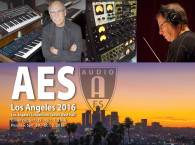 The Audio Engineering Society is hosting its 57th International Conference, the “Future of Audio Entertainment Technology: Cinema, Television, and the Internet,” on Friday, March 6, through Sunday, March 8, 2015, at the world-renowned TCL Chinese 6 Theatres in Hollywood, California.
The Audio Engineering Society is hosting its 57th International Conference, the “Future of Audio Entertainment Technology: Cinema, Television, and the Internet,” on Friday, March 6, through Sunday, March 8, 2015, at the world-renowned TCL Chinese 6 Theatres in Hollywood, California.One particular focus will be the recent joint SMPTE report on B-Chain cinema sound standards, which revealed many deficiencies both in theaters and in movie dubbing rooms. These issues and more will be the subject of presentations by Dr. Floyd Toole, Dr. Peter Mapp, and others at the 57th Conference.
Cinema sound is on the cusp of its most complex new inflection point since the arrival of 5.1 surround sound nearly 40 years ago, and new multichannel formats promise a rich, highly immersive audio environment for cinemagoers and home theaters alike. However, these new formats, which can scale as high as 11 or more discrete channels and multiple LFE channels, will require substantial research and study to develop best practices for their harmonized implementation. A series of panels, papers and workshops at the AES 57th Conference will focus squarely on these new challenges.
In particular, the conference’s first day will address the SMPTE 25CSS B-Chain report on the Standards; work done by a joint SMPTE/AES committee resulted in the paper “B-Chain Frequency and Temporal Response Analysis of Theatres and Dubbing Stages,” which delves into current standards and practices regarding B-chain electroacoustic response and calibration.

(Cinema sound management is divided into two sections: the A-chain refers to the soundtrack media and various decoders such as Dolby and DTS; B-chain refers to power amplifiers, crossovers and speakers, including cinema EQ.) The paper was produced with extensive participation from AES members and will serve as a foundation for further necessary advancements in audio technology in the Sound for Picture arena.
Many other timely topics will be covered during the Cinema Audio portion of the conference, such as “Predicting the In-Room Response of Cinemas from Anechoic Loudspeaker Data,” a paper that makes the case that cinema measurement and calibration should place increased focus on the anechoic data of the loudspeaker being utilized.
Another paper, “The Audibility of Comb-Filtering Due to Cinema Screens,” asserts that by modeling the speaker-screen combination using MATLAB, the behavior of the perforated screen, when subjected to an incident sound wave, can be predicted, along with how filters for different separations between screen and loudspeaker can be effectively used to create a database of simulated output signals that represent a portion of cinema audio being played through the screen/loudspeaker system in different geometric setups.
With the paper “Electroacoustic Measurements on Cinema B Chains in Australia,” researchers using time-gated techniques (MLSSA) and traditional pink-noise Real Time Analyzer (RTA) processes compare manufacturer-published measurements, while giving probable cause for inherent discrepancies.
“Equalizing Effects of Perforated Movie Screens and the Future” considers how cinema screens form a low-pass filter that attenuates the high-frequency response of cinema loudspeakers, and reports on measurements of the spectral content of several movies and assesses the impacts on the headroom in the playback chain, along with other important factors affecting overall performance.
In addition to these and other delivered papers, the Cinema Audio portion of the conference will also feature several workshops. “Low Frequency Issues: Cinema/Home/Internet” is chaired by Anthony Grimani, President, MSR Inc., and features input from panelists Manny LaCarrubba, Chief Engineer, Sausalito Audio; and Glenn Leembruggen, Acoustic Directions Pty. Ltd., Sydney University.
The workshop “Great Picture – Pity about the Dialogue — Speech Intelligibility and Dialog Clarity in Film, TV and Audio Entertainment” is being chaired by Peter Mapp, Peter Mapp Associates, Colchester, UK, and features panelists Lon Bender, Hearing is Precious; Kurt Graffy, Arup Engineering; and David L. Smith, Bose Corp.
“Sound for picture and Cinema Audio as a whole are in the process of undergoing their most profound upheaval in decades,” observes AES 57th Conference co-chair Dr. Sean Olive. “New multichannel audio formats will bring a new level of immersive experience to pictures in cinemas and at home. But how these formats are utilized by audio professionals around the world will have to be standardized sufficiently, so that everyone will have a consistently excellent experience, every time. That’s the important work that these papers and workshops continue to explore during the conference.”
www.aes.org/conferences/57/
Read more about the AES 57th Conference on The Future of Audio Entertainment Technology here.






